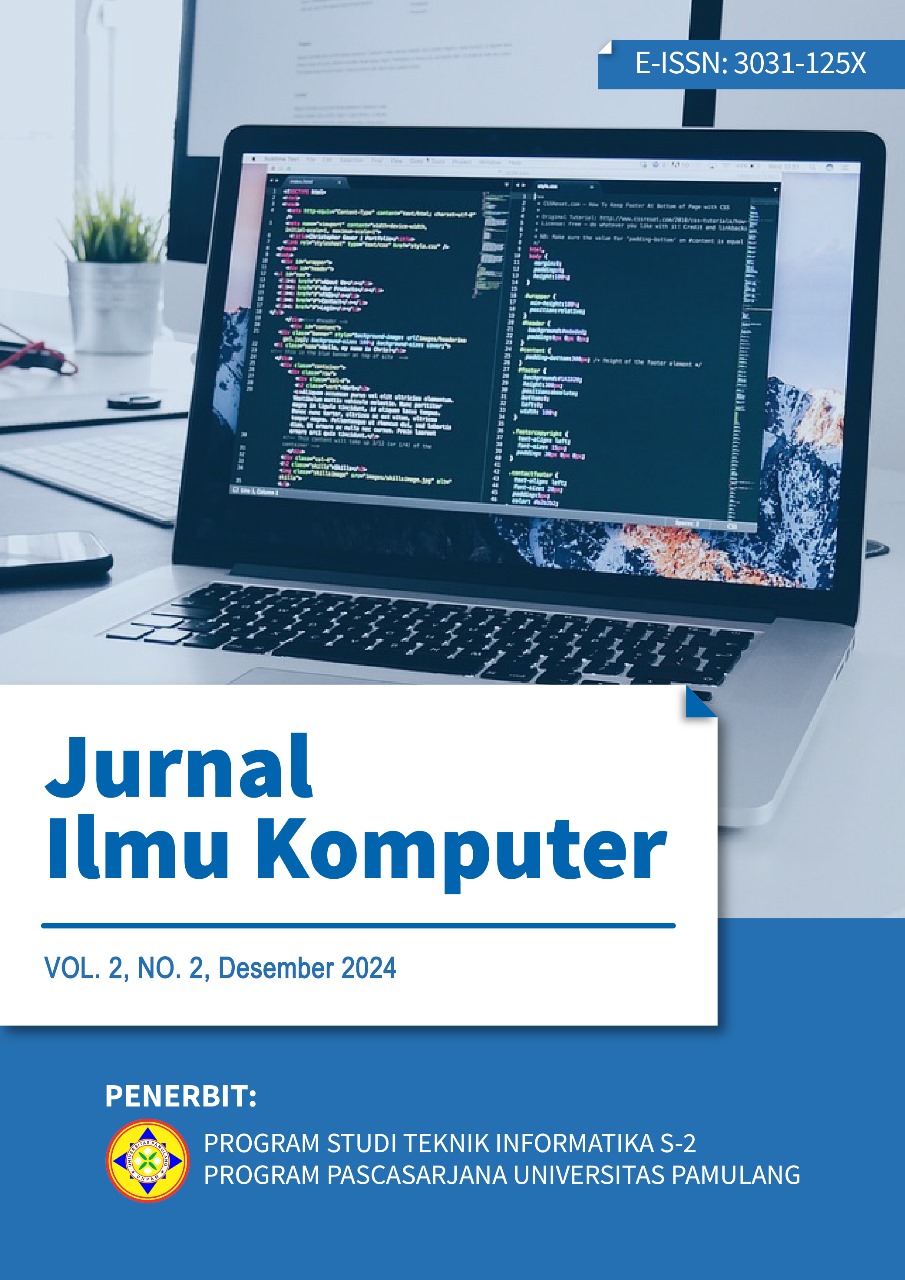Analisis Kinerja Sistem Deteksi Intrusi Jaringan Internet Of Things Berbasis Metode Ensemble
Keywords:
DDoS Attack Analysis, Ensemble, Decision Tree, RT_IOT2022Abstract
Network intrusion has rapidly evolved, posing significant risks to IT infrastructure. To address this, ensemble learning, known for its robust classification capabilities, is applied to IoT network traffic using the public RT_IOT2022 dataset. Models such as CatBoost, Extreme Gradient Boost (XGBoost), and LightGBM were developed and evaluated. The dataset was normalized using the Normalizer and MinMaxScaler functions from the scikit-learn framework. Model training was conducted with an 80:20 fixed data split for training and testing, along with 5-fold cross-validation. Testing revealed that XGBoost with MinMaxScaler and the 80:20 split achieved the highest accuracy of 99.89%. However, accuracy decreased to 94.04% when using 5-fold cross-validation. Nevertheless, XGBoost with MinMaxScaler consistently demonstrated the fastest computation time across all schemes. For instance, it required only 15 seconds for the fixed split scheme compared to 59 seconds for 5-fold cross-validation. These findings highlight the efficiency and accuracy of XGBoost when combined with MinMaxScaler under specific validation schemes.
References
[1] I. Sharafaldin, A. Lashkari, S. Hakak and A. Ghorbani, Developing Realistic Distributed Denial of Service (DDoS) Attack Dataset and Taxonomy, International Carnahan Conference on Security Technology (ICCST) 2019., 2019.
[2] K. Prasad, DoS and DDoS Attacks:Defence, Detection and Traceback Mechanism -A Survey., Global Journal of Computer Science, 2014.
[3] N. Meti, D. G. Narayan and V. P. Baligar, Detection of Distributed Denial of Service Attacks Using Machine Learning Algorithms in Software Defined Networks, International Conference on Advances in Computing, Communications and Informatics (ICACCI), 2017.
[4] E. Hodo, X. Bellekens, E. Iorkyase, A. Hamilton, C. Tachtatzis and R. Atkinson, Machine Learning Approach for Detection of non Tor Traffic, Proceedings of the 12th International Conference on Availability, Realiability and Security, 2017.
[5] G. Airlangga, Comparative Analysis of Machine Learning Models for Intrusion Detection in Internet of Things Network Using the RT-IoT2022 Dataset, Malcom: Indonesia Journal of Machine Learning and Computer Science, 2024, 2024.
[6] B. Sharmila and R. Nagapadma, Sistem Deteksi Intrusi Quantized Autoencoder (QAE) Untuk Deteksi Anomali Pada Perangkat IoT Dengan SUmber Daya Terbatas Menggunakan Kumpulan Data RT-IoT2022, Keamanan Siber Sharmila dan Magapadma (2023), 2023.
[7] G. R. Kumar, N. S. Govekar, A. Karthik, G. Nijhawan, A. H. Alawadi and A. V, Real-TIme Monitoring and Anomaly Detection in Hospital IoT Networks Using Machine Learning, 2023 International Conference on Artificial Intelligence for Innovation in Healtcare Industries, 2023.
[8] F. Muhammad, I. Wahidah and A. I. Irawan, Analisis Pendeteksian Serangan Denial of Service (DoS) Menggunakan Logika FUzzy Metode Mamdani Pada Jaringan Internet of Things, e-Prociding of Engineering, 2021, 2021.
[9] M. R. Alfine and M. Arman, Analisis Serangan DDoS Menggunakan Metode Jaringan Saraf Tiruan, Jurnal SISFOKOM (Sistem Informasi dan Komputer), 2020., 2020.
[10] A. Zukhruf, B. Fatkkurrozi and A. A. Kurniawan, Comparative Study of Distributed Denial of Service (DDoS) Attack Detection in Computer Networks, Jurnal Teknik Informatika (JUTIF), 2023., 2023.
[11] H. Tantriawan, R. A. Yunmar, A. Setiawan and M. Suryadi, Deteksi Distributed Denial of Service (DDoS) Menggunakan Fuzzy Logic Sugeno, Malcom: Indonesia Journal of Machine Learning and Computer Science, 2021., 2021.
[12] L. Prokhorenkova, L. Guseb, A. Vorobev, A. Dorogush and A. Gulin, Catboost: unbiased boosting with categorial features [online], https://github.com/catboost/catboost, 2019.
[13] J. Friedman, Greedy Function Aproximation A Gradient Boosting Machine, Annals of Statistics, 29(5), 1189-1232, 2001.
[14] M. Hao, S. Hejiang, L. Junjie and W. Shen, Developing window behavior models for residential buildings using XGBoost algorithm., Energy and Buildings, 205, 109564. https://doi.org/10.1016/j.enbuild.2019.109564, 2019.
[15] G. Ke, Q. Meng, T. Finley, T. Wang, W. Chen, M. Weidong, Q. Ye and L. Tie-Yan, LightGBM: A Highly Efficient Gradient Boosting Decision Tree, Advances in neural information processing systems, 30, 3146-3154, 2017.
[16] W. Liang, S. Luo, G. Zhao and H. Wu, Predicting Hard Rock Pillar Stability Using GBDT, XGBoost, and LighGBM, Mathematics 8(5), 765, https://doi.org/10.3390/math8050765, 2020.
[17] D. D. Rufo, T. G. Debelee, A. Ibenthal and W. G. Negera, Diagnosis of Diabetes Mellitus Using Gradient Boosting Machine (LightGBM), Diagnostics 11(9), 1714, https://doi.org/10.3390/diagnostics11091714, 2021.
[18] T. T. Wong, Performance evaluation of classification algorithm by k-fold and leave-one-out cross validation, Pattern Recognition, vol. 48 no.9, pp. 2839-2846 sep. 2015, doi:10.1016/j.patcog.2015.03.009, 2015.
[19] L. Prokhorenkova, G. Guseb, A. Vorobev, A. V. Dorogush and A. Gulin, Catboost: unbiased boosting with categorial features [online], https://github.com/catboost/catboost, 2019.
[20] I. Sharafaldin, A. H. Lashkari, S. Hakak and A. A. Ghorbani, Developing Realistic Distributed Denial of Service (DDoS) Attack Dataset and Taxonomy, 2019 International Carnahan Conference on Security Technology (ICCST), 2019.
[21] S. Artificial Intelligence: Searching, Reasoning, Planning and Learning(2nd ed)., Informatika, Bandung, Indonesia., 2014.
[22] I. Mengenal Decision Tree dan Manfaatnya, https://medium.com/iykra/mengenal-decision-tree-dan-manfaatnya-b98cf3cf6a8d, 2018.
[23] L. Prokhorenkova, G. Guseb, A. Vorobev, A. Dorogush and A. Gulin, Catboost: unbiased boosting with categorial features [online]., 2019: https://github.com/catboost/catboost.
Downloads
Published
Issue
Section
License
Copyright (c) 2025 Eko Kristianto Sukarmi, Arya Adhyaksa Waskita

This work is licensed under a Creative Commons Attribution-ShareAlike 4.0 International License.



